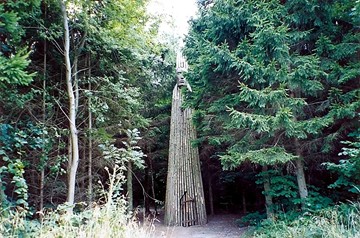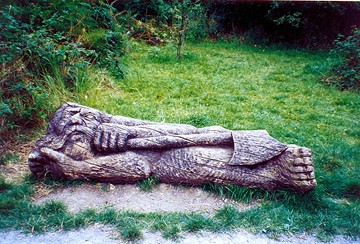
A window in the wood on
contemporary art
by REX NEEDLE
|
Art in public places is at a disadvantage from the start because the vandals are forever at the gates waiting to deface or tear down any accessible structure that endeavours to educate and stimulate. Despite this drawback there have been several attempts around the district in recent years to bring art to the people, notably in Bourne Wood where a much-heralded sculpture trail was launched in the summer of 1991 by the Forestry Commission in conjunction with local authorities and community groups, a project designed to attract more visitors and at the same time enable resident artists execute and display their work in a woodland setting. Seven artists were commissioned to produce work that would fit easily into the location, so taking art out of the gallery and into a natural environment, the project being funded by South Kesteven District Council, Lincolnshire County Council and the Eastern Arts Board in partnership with Forest Enterprise and Bourne Grammar School. The sculptures commissioned varied in their degree of abstraction and not all met with universal approval because some were vandalised and others totally ignored while today, signs of this worthy project are difficult to find and identify. One of the first to be erected was an impressive work called Window in the Wood by Claire Guest (pictured above), a lofty creation sited on the brow of a hill beside a turn on the main track, the 30 foot high sculpture depicting woodland creatures springing between the curved sides of the arch which was intended to create a two-dimensional pattern against the sky. But it did not win the admiration of all visitors because it was vandalised on several occasions and parts were replaced but in the summer of 2001 the damage became so extensive that it was dismantled altogether. Then in 1997, Clare Wilks, who was described as “an artist with a growing international reputation”, created a living willow sculpture called Helter Shelter at the junction of two forest tracks, the passageway of woven willow fence spiralling the visitor in towards the small opening of a central, densely woven structure and since it was living and growing, the shelter was intended to respond to the changes of the seasons, putting forth new growth in spring or shedding leaves in autumn. But that too was badly damaged by vandals lighting a fire inside and what was left subsequently became overgrown and neglected and although restored in the spring of 2003 by a basket weaving group from King's Cliffe, near Stamford, who also offered to maintain it annually and this enthusiasm has helped preserve it for posterity. There were more works completed as part of the sculpture trail and signs of some can still be seen here and there, notably an odd representation by John Fortnum of Robert de Brunne, better known as Robert Manning, the monk who lived and worked at Bourne Abbey during the 14th century.
The statue was approached by a gravelled path from the main track, at the beginning of which a giant footprint gave a first intimation of the sculpture's presence and the path then wound through dark pines, emerging at the rear of this gigantic piece, a vertical cone of pine logs soaring 30 feet and broken only by the cast concrete head which gazed with remarkable presence across an open area near the lakes, over the trees beyond towards Sempringham Abbey, the home of Robert's order of Gilbertine monks where he had lived before moving to Bourne. This timber tower with an internal ladder and viewing platform was believed at the time to be the largest work completed by a British sculptor working alone. It was also the most controversial of all the exhibits, provoking considerable argument about its artistic merit, and one dark night it was even set on fire although it became a joke around town that the culprits were not vandals but exasperated art critics. There are also remains of a remarkable undertaking by Kerry Morrison entitled Mushroom Rings located close to the main track through the centre of the wood where a path rises from a gravelled clearing and two circles of giant carved mushrooms are glimpsed through the trunks of the pines. The artist carved mainly from oak using a chainsaw and all were completed over a period of weeks in the forestry workshop near the Beech Avenue entrance despite complaints about the continual noise from people living in the vicinity. John Fortnum also worked with students from the sixth form at Bourne Grammar School to create a number of "milestone" sculptures in cast concrete which were sited throughout the wood including Crinoline Lady and Owl, while students from the now defunct Social Education Centre in Pinfold Road which provided training and tuition for young people with learning difficulties, produced a sculpture from copper plates which oxidised in their outdoor environment and eventually turned green, thus blending with the woodland surroundings. This unusual work was suspended between a pair of pine trees near to the main path through the wood where after several years it took on the appearance they anticipated and had many admirers among woodland walkers. It was never given a name and so I suggested to the Forestry Commission that it be called Woodland Verdigris which appears to have stuck. Several further works were added to the original trail, the last in the summer of 2003, two by Clare Wilks who had previously created Helter Shelter and were again commissioned by South Kesteven District Council without being put out to tender which reflected a confidence in her previous work. Both were made from willow and copper and installed in the top of two ash trees which mark the entrance to the main car parking area of Bourne Wood. One was called Nest, having been created partly in imitation of a squirrel drey, while Horn brought a more human influence to contrast with its sister sculpture. "I opened up one end so that the viewer can peer inside and thereby engage more directly with the work", explained Clare. "The resulting form, enhanced by the polished copper, could be a giant primitive musical instrument, such as a horn, and this suggests a human presence in the wood whereas the Nest suggests animals. The swooping shape could alternatively suggest the hornpipe dance or simply the horn on an animal's head." These creations looked good perched up there in the branches but despite the elaborate explanation of the artist many visitors remained puzzled. Another late addition was Woodland Tunnel which was added in the summer of 2002, four pieces of curved timber of diminishing size and erected in line to create a tunnel effect, the work of students from the School of Sculpture at the Emerson College in East Sussex. All were made with wood obtained from sixty-year-old oak trees cut at Temple Wood, five miles north of Bourne and can still be seen situated near to the public car park and lead visitors directly to the main woodland trail. Most of the other exhibits have disappeared while those that remain are neglected and often hard to find and so a worthy and well-meaning project that did manage to stimulate some interest for a few years has foundered through public indifference.
Although the original sculpture trail is no more, the remains of several creations can still be seen by vigilant walkers, such as The Woodsman by Simon Todd, a figure carved from a tree trunk by the main car park where he lies in an open space at the junction of several paths, an axe beside him, open hand beneath his chin, like an ancient spirit of the woods inviting us to explore the more secluded ways. Todd skilfully carved the figure so that it retained the qualities of the section of fallen ash from which it is fashioned but today it lies forgotten and neglected and resembling little more than a gnarled chunk of unwanted timber rather than its original intention. One of the more enduring exhibits that can still be seen alongside the main path from Beech Avenue was entitled Sculpture for the Wood, a traditional work carved from a large block of Ancaster stone by Paul Morrison portraying a couple sitting and relaxing amid the bracken which he described as “a metaphor of our relationship with the woodland”. This particular work above all others relates to the popular perception of sculpture, one that depicts a familiar subject and is executed in the material most favoured by artists. Most of the others had an appearance that seemed to invite the attention of the destructive and a fragility unlikely to survive the years while those who remember them will recall the debate over whether they were art in the true sense, that is the creation of beauty through the expression of skill and imagination, or mere flights of fancy with no chance of permanence. But then, after seeing Tracey Emin’s unmade bed or Damien Hirst’s formaldehyde sheep it is obvious that the boundaries of this diverse range of human activity were pushed back long ago and although no one should shrink from giving expression to their own imagination in this type of art form it is a matter for debate whether they should be financed by public money, especially when it emanates from the council tax we pay which is intended to provide the services on which our communities depend.
|

